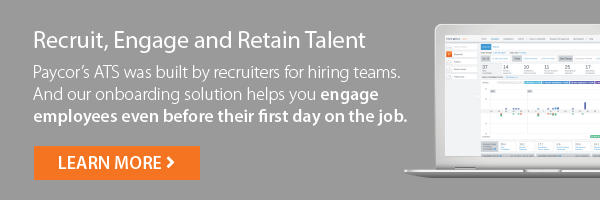Commonly referred to as an ATS, this product provides a central applicant database, set of processes and collaboration tools to help employers manage recruitment and hiring efforts. From providing applicants a way to apply to jobs online to managing and tracking interview processes, think of applicant tracking systems as supply chain software for hiring.
Applicant tracking systems are also referred to as: ATS, applicant tracking software, hiring software, recruiting software.
There Are Two Types Of Applicant Tracking Systems
For Employers
Technology designed for HR and recruiting departments to manage and organize internal hiring processes. (Paycor Recruiting is for employers not recruiting agencies).
For Recruiting Companies
Technology used by recruiting agencies, executive search firms, and staffing agencies to manage external recruiting projects.
Paycor Recruiting is designed for HR, employers and internal recruiting teams. It’s common for people to use the terms, “applicant tracking system” and “recruiting software” interchangeably, but there are two distinct types of platforms.
Modern Applicant Tracking Systems (ATS) Are In The Cloud
Software as a Service (SaaS) applications, also known as cloud-based applications, are products hosted and managed in a datacenter, paid for on a subscription basis and accessed via browser or mobile device over an internet connection. For employers, there are many benefits to be had from adopting the SaaS / cloud model including:
No Maintenance
Cloud-based applicant tracking systems like Paycor Recruiting require very little initial and on-going IT support. Once Paycor Recruiting is up and running, our team provides fast, free technical support.
Scalability
As your needs grow and you need to add more Administrative users, you can adjust your monthly subscription as required. Scale up and down depending on your needs.
Constant Upgrades
Applicant tracking systems like Paycor Recruiting are updated automatically at least 8 times a year. Updates are pushed to employers in real-time keeping your ATS perpetually current.
Accessibility
A browser and an internet connection is all that’s required to access a SaaS application like Paycor Recruiting, which can therefore be made available on a wide range of desktop and mobile devices.
Paycor Recruiting is designed for HR, employers and internal recruiting teams. It’s common for people to use the terms, “applicant tracking system” and “recruiting software” interchangeably, but there are two distinct types of platforms.
Trending in The Applicant Tracking System (ATS) World
Responsive is the New Mobile
When an ATS vendor says their platform can be accessed on a mobile device, they mean that their product can be viewed on a mobile device, but it doesn’t mean that it works well without being frustrating and slow. New responsive design understands what screen size is being used to access the product. With responsive products like Paycor Recruiting, users never have to download or sign into a separate app to use while on the go.
Hiring Manager Collaboration
Modern applicant tracking systems like Paycor Recruiting are easy-to-use and operate on any device encouraging managers to make decisions, share notes and provide interview feedback online. Smart products like Paycor Recruiting even have features that allow managers to participate in the recruiting process without logging into the Applicant Tracking System.
Recruiting Dashboards
Unfortunately, until recently, applicant tracking systems weren’t much to look at. Worse, most systems continue to be designed by engineers and product managers that don’t understand recruiting. However, systems like Paycor Recruiting are designed by people that know recruiting. The results are easy-to-read dashboards that serve as air-traffic control for recruiting programs and analytics dashboard that empower users to view data related to recruiting performance at-a-glance.
These days you can choose an ATS with every feature known to man. Focus on what’s important. Smart employers realize that the easiest way to hire better people is to simplify the recruiting process.
Hire Faster & Smarter with Paycor Recruiting
Finding, interviewing and hiring talented people are the most important challenges growing businesses face. Paycor Recruiting is a software solution designed and built by recruiters for recruiters and HR hiring teams to help you solve your hiring problems and optimize your recruiting process.










